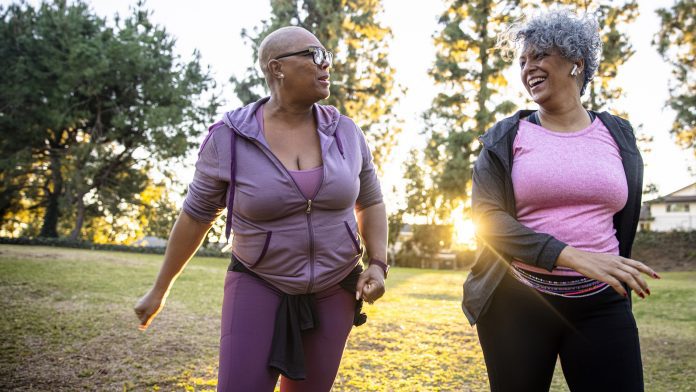
New data from more than 400,000 UK adults reveals a clear link between walking pace and a genetic marker of biological ageing.
Researchers from the University of Leicester at the National Institute of Health Research (NIHR) Leicester Biomedical Research Centre studied genetic data from 405,981 middle-aged UK Biobank participants to determine whether walking pace contributes to slowing biological ageing.
The research was published in the journal Communications Biology.
Only 10 minutes of a brisk walking pace could be enough
The researchers discovered a clear link between a brisk walking pace and slowing biological age. To measure this, they focussed on leucocyte telomere length (LTL), which is associated with biological age and walking pace.
They found, by utilising data from the UK Biobank, that as little as 10 minutes of brisk walking a day is associated with longer life expectancy, and that a brisk walking pace has up to 20 years’ greater life expectancy compared to slow walkers.
This new study demonstrates a causal link between brisk walking and slowed biological age and, significantly, not the other way round.
Tom Yates, a senior author and Professor of Physical Activity, Sedentary Behaviour and Health at the University of Leicester and NIHR Leicester Biomedical Research Centre, added: “Whilst we have previously shown that walking pace is a very strong predictor of health status, we have not been able to confirm that adopting a brisk walking pace actually causes better health. In this study, we used information contained in people’s genetic profiles to show that a faster walking pace is indeed likely to lead to a younger biological age as measured by telomeres.”
The science
The research team confirmed a causal link between walking pace and leucocyte telomere length (LTL) – an indicator of biological age. They found that a lifetime of brisk walking could lead to the equivalent of 16 years younger biological age by midlife.
Telomeres are the ‘caps’ at the end of each chromosome and hold repetitive sequences of non-coding DNA that protect the chromosome from damage, similar to the way the cap at the end of a shoelace stops it from unravelling.
Each time a cell divides, these telomeres become so short that they can no longer divide, known as ‘replicative senescence’. The scientists believe that due to this, LTL is a strong marker for biological age, independent of when an individual is born.
The relationship between telomere length and disease is not fully understood; the build-up of these cells is believed to contribute to a range of symptoms associated with ageing, such as age-related diseases.
The physical, mental, social and health benefits of walking are well-documented; this study is the first to compare genetic data with both self-reported walking pace speeds and actual measurements of movement intensity from wearable activity tracking devices worn by participants.
Dr Paddy Dempsey is a Lecturer and Research Fellow at the University of Leicester and within the NIHR Leicester Biomedical Research Centre, part of the University Hospitals of Leicester (UHL) NHS Trust, and the lead author of the study. He said: “Previous research on associations between walking pace, physical activity and telomere length has been limited by inconsistent findings and a lack of high-quality data.
“This research uses genetic data to provide stronger evidence for a causal link between faster walking pace and longer telomere length. Data from wrist-worn wearable activity tracking devices used to measure habitual physical activity also supported a stronger role of habitual activity intensity (e.g. faster walking) in relation to telomere length.
“This suggests measures such as a habitually slower walking speed are a simple way of identifying people at greater risk of chronic disease or unhealthy ageing, and that activity intensity may play an important role in optimising interventions. For example, in addition to increasing overall walking, those who are able could aim to increase the number of steps completed in a given time (e.g. by walking faster to the bus stop). However, this requires further investigation.”
























